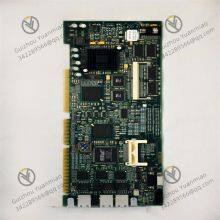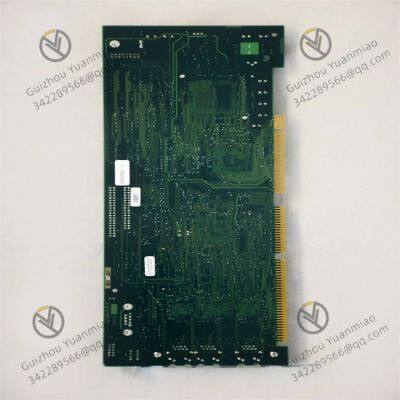Emerson 5X00105G07 controller module

Detailed Introduction to 5X00105G07 Controller ModuleI. Module Positioning and Core Functions
The 5X00105G07 is an industrial-grade controller module that serves as the core computing unit of automation systems. It is primarily used for logic control, data processing, and communication with external devices. Its core functions include:
Logic and Algorithm Control: Supports PLC programming (e.g., ladder diagrams, ST language) for sequential control, PID regulation, data operations, etc., suitable for automating complex industrial processes.
Multi-Device Coordination Management: Connects sensors, actuators, and other modules via buses or communication protocols (e.g., Modbus, EtherCAT) to enable real-time data acquisition and command output.
System Monitoring and Fault Handling: Built-in diagnostic functions continuously monitor operational status and provide early warnings or protective responses to anomalies (e.g., communication interruptions, hardware failures).
II. Core Performance Indicators
| Parameter Dimension | Specific Indicators |
|---|
| Processor Performance | - 32-bit high-performance CPU with ≥100MHz, supporting floating-point operations and processing speeds up to 1ns/instruction.
- Built-in high-speed cache (L1/L2) for enhanced data processing efficiency. |
| Memory Configuration | - Program memory: Typically 256KB~1MB (Flash), supporting user program storage and power-down retention.
- Data memory: 128KB~512KB (RAM) for real-time data caching. |
| Communication Interfaces | - Standard 2~4 communication ports: Support Ethernet (10/100Mbps), RS485/RS232, CANopen, etc.
- Optional support for industrial Ethernet protocols such as PROFINET and EtherNet/IP. |
| I/O Expansion Capability | - Connectable to analog/digital I/O modules, communication modules, etc., with a maximum expansion capacity of ≥512 channels (subject to system architecture). |
| Data Processing Capacity | - Real-time clock (RTC) with ±50ppm accuracy; supports data logging (e.g., fault records, operational parameters).
- Supports PID control (sampling period ≤1ms) and high-speed counting (input frequency ≥100kHz). |
| Operating Environment | - Temperature: -40°C~70°C (industrial grade), Humidity: 5%~95% (non-condensing).
- Vibration/shock resistance: Complies with IEC 61000-6-2 standard for harsh industrial environments. |
| Power Supply Specifications | - DC power: 24V DC (±10%), power consumption ≤10W; optional redundant power input for enhanced system reliability. |
III. Unique Design and Technical Advantages
Modularity and Scalability
Hot-swappable design allows module replacement without powering down, minimizing downtime; high-speed backplane bus (bandwidth ≥100Mbps) ensures real-time data transmission.
Compatible with same-series I/O and communication modules for mixed installation, adapting to control systems of various scales (from small standalone units to large DCS systems).
Software and Programming Compatibility
Compatible with mainstream programming software (e.g., IEC 61131-3 compliant development environments), supporting programming languages such as ladder diagrams (LD), structured text (ST), and function block diagrams (FBD).
Built-in simulation and debugging tools enable online programming, breakpoint debugging, and program version management, reducing development and maintenance costs.
Safety and Reliability Design
Hardware Level: Built-in ESD protection, overvoltage/overcurrent protection circuits, and industrial-grade components for critical chips; program storage with CRC verification to prevent data corruption.
Software Level: Fail-Safe function automatically switches to a safe output mode (e.g., maintaining the last state or a preset value) upon detecting hardware failures.

IV. Installation and Communication Configuration
Physical Installation
DIN rail mounting (35mm standard), supporting horizontal/vertical installation with a minimum module spacing of ≥20mm for heat dissipation; detachable terminal blocks facilitate wiring and maintenance.
During installation, distinguish between power terminals (24V DC±, GND), communication interfaces (e.g., Ethernet RJ45, RS485 terminals), and expansion bus interfaces.
Communication and Networking
Ethernet Communication: Supports TCP/IP and UDP protocols for communication with host computers (SCADA), HMIs, or other controllers, enabling data exchange and remote monitoring.
Fieldbus: Optional modules support protocols such as PROFIBUS and Modbus RTU for connecting sensors or actuators (e.g., flow meters, frequency converters).
Configuration Tools: Set IP addresses, communication parameters, and I/O mapping via dedicated software (e.g., manufacturer-provided configuration tools), supporting Plug & Play functionality.
V. Typical Application Scenarios
Process Industry Automation
Controls parameters such as temperature, pressure, and in chemical, petroleum, and pharmaceutical industries using PID algorithms for closed-loop regulation, while integrating with DCS systems for plant-wide production monitoring.
Discrete Manufacturing and Machinery Control
Executes logic control (e.g., process sequencing), motion control (e.g., servo motor positioning), and real-time interaction with sensors (encoders, photoelectric switches) in packaging machinery and CNC machines to ensure precise operation.
Energy and Municipal Sectors
Enables substation automation in smart grids, pump control in wastewater treatment plants, or logic control of HVAC and lighting in building management systems (BMS), supporting remote operation and energy consumption monitoring.
VI. Maintenance and Fault Troubleshooting
Routine Maintenance: Regularly check module indicator lights (power, communication, operation status) and clean cooling vents to prevent dust accumulation.
Fault Diagnosis: Read error codes via programming software (e.g., E001 for communication timeout, E003 for memory error) and locate issues using hardware indicators (e.g., channel fault lights).
Firmware Upgrade: Supports online firmware upgrades via Ethernet to fix bugs or add new features, requiring stable power supply during the process.
Summary
The 5X00105G07 controller module, with its high-performance processing, flexible scalability, and robust reliability, serves as a core component in industrial automation systems. It is ideal for scenarios requiring real-time control, complex logic operations, and multi-device coordination, effectively enhancing system stability and intelligence. For more specific technical parameters (e.g., dimensions, weight, certification standards), refer to the manufacturer's official documentation.













































